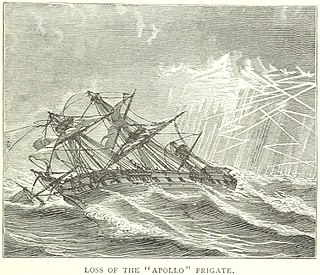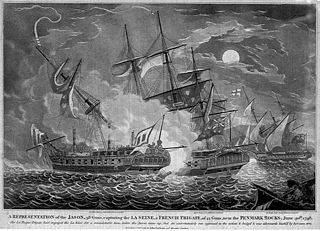Related Research Articles

HMS Indefatigable was one of the Ardent class 64-gun third-rate ships-of-the-line designed by Sir Thomas Slade in 1761 for the Royal Navy. She was built as a ship-of-the-line, but most of her active service took place after her conversion to a 44-gun razee frigate. She had a long career under several distinguished commanders, serving throughout the French Revolutionary Wars and the Napoleonic Wars. She took some 27 prizes, alone or in company, and the Admiralty authorised the issue of four clasps to the Naval General Service Medal in 1847 to any surviving members of her crews from the respective actions. She was broken up in 1816.
HMS Thunderer was a ship of the line of the Royal Navy, built in 1783. It carried 74-guns, being classified as a third rate. During its service it took part in several prominent naval battles of the French Revolutionary Wars and the Napoleonic Wars; including the Glorious First of June, the Battle of Cape Finisterre and the Battle of Trafalgar.

HMS Pickle was a topsail schooner of the Royal Navy. She was originally a civilian vessel named Sting, of six guns, that Lord Hugh Seymour purchased to use as a tender on the Jamaica station. Pickle was at the Battle of Trafalgar, and though she was too small to take part in the fighting, Pickle was the first ship to bring the news of Nelson's victory to Great Britain. She also participated in a notable single-ship action when she captured the French privateer Favorite in 1807. Pickle was wrecked in 1808, but without loss of life.
HMS Renown was a 74-gun third-rate ship of the line of the Royal Navy. She was to have been named HMS Royal Oak, but the name was changed to Renown on 15 February 1796. She was launched at Deptford Wharf on 2 May 1798 and served in 1800-1801 as the flagship of Sir John Borlase Warren, initially in the English Channel.

HMS Anson was a ship of the Royal Navy, launched at Plymouth on 4 September 1781. Originally a 64-gun third rate ship of the line, she fought at the Battle of the Saintes.

HMS Apollo, the fourth ship of the Royal Navy to be named for the Greek god Apollo, was a fifth-rate frigate of a nominal 36 guns. She was the name ship of the Apollo-class frigates. Apollo was launched in 1799, and wrecked with heavy loss of life in 1804.
There have been five ships of the Royal Navy to bear the name HMS Urchin after the Sea urchin:

HMS Northumberland was a 74-gun third-rate ship of the line of the Royal Navy, built at the yards of Barnard, Deptford and launched on 2 February 1798.
HMS Spencer was a 74-gun third-rate ship of the line of the Royal Navy, launched on 10 May 1800 at Bucklers Hard. Her designer was the French émigré shipwright Jean-Louis Barrallier. She served in two major battles, Algeciras Bay and San Domingo, and in a number of other campaigns. She was broken up in 1822.

America was a Téméraire-class 74-gun ship of the line of the French Navy. The Royal Navy captured her in 1794 at the Battle of the Glorious First of June. She then served with the British under the name HMS Impetueux until she was broken up in 1813. She became the prototype for the Royal Navy America-class ship of the line.

Uranie was a frigate of the French Navy launched in 1788. She took part in a frigate action in 1793, capturing HMS Thames, and was renamed Tartu in honour of her captain, Jean-François Tartu, who was killed in the action. The Royal Navy captured her in 1797. She served as HMS Uranie until the Royal Navy sold her in 1807.

HMS Amethyst was a Royal Navy 36-gun Penelope-class fifth-rate frigate, launched in 1799 at Deptford. Amethyst served in the French Revolutionary Wars and the Napoleonic Wars, capturing several prizes. She also participated in two boat actions and two ship actions that won her crew clasps to the Naval General Service Medal. She was broken up in 1811 after suffering severe damage in a storm.

HMS Lowestoffe was a 32-gun fifth-rate frigate of the Royal Navy. Built during the latter part of the Seven Years' War, she went on to see action in the American War of Independence and the French Revolutionary War, and served often in the Caribbean. A young Horatio Nelson served aboard her shortly after passing his lieutenant's examination.

Seine was a 38-gun French Seine-class frigate that the Royal Navy captured in 1798 and commissioned as the fifth-rate HMS Seine. On 20 August 1800, Seine captured the French ship Vengeance in a single ship action that would win for her crew the Naval General Service Medal. Seine's career ended in 1803 when she hit a sandbank near the Texel.

HMS Santa Dorothea was a Royal Navy 34-gun fifth rate. This frigate had previously served in the Spanish Navy under the name Santa Dorotea. Built in Spain in 1775, she served during the early years of the French Revolutionary Wars until being captured while sailing as part of a squadron off Cartagena. Taken into British service, she spent the rest of the French Revolutionary and most of the Napoleonic Wars under the white ensign, until being broken up in 1814.

HMS Brilliant was a 28-gun Enterprise-class sixth-rate frigate of the Royal Navy. Brilliant was first commissioned in July 1779 under the command of Captain John Ford.
HMS Incendiary was an 8-gun fireship of the Royal Navy. She was present at a number of major battles during the French Revolutionary Wars, and captured, or participated in the capture, of several armed vessels. In January 1801 she was in the Gulf of Cadiz where she encountered Admiral Ganteume's squadron. The 80-gun French Navy ship of the line Indivisible received the credit for the actual capture.

Etna was a French naval Etna-class ship-sloop launched in 1795 that the Royal Navy captured in November 1796. She was taken into service as HMS Aetna and renamed to HMS Cormorant the next year. She captured several merchant vessels and privateers before she was wrecked in 1800 off the coast of Egypt.

HMS Seahorse was a 38-gun Artois-class fifth-rate frigate of the Royal Navy. She was launched in 1794 and broken up in 1819.
John Bradley Harbord (1812-1896) was a Church of England priest and author.
References
- ↑ Colledge, J.J (2003). Ships of the Royal Navy : the complete record of all fighting ships of the Royal Navy (Rev.. ed.). London: Greenhill. p. 121. ISBN 1853675660.
- ↑ London Gazette Issue 15274 page 782 8 July 1800
- ↑ London Gazette Issue 15297 page 1123 27 September 1800
| This article about a specific naval ship or boat of the United Kingdom is a stub. You can help Wikipedia by expanding it. |